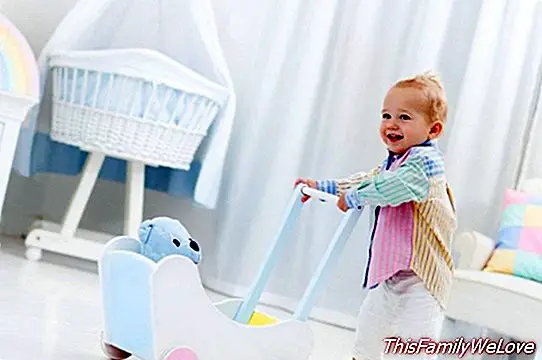This develops the baby's sense of balance

The sense of balance it provides us with a permanent orientation in the three dimensions of space. For this, he uses different structures such as the vestibular apparatus, the eyes and the cutaneous and deep sensibility. Of all of them, the vestibular apparatus of the inner ear is the most specific organ of balance.
In this place the information of the spatial situation of the head, of the different parts of the body and of the pressure exerted on any area of the skin is captured. A complex process that gets it to take place the miracle of balance.
All these impressions captured through the senses are transmitted to the cerebellum and to the higher nervous centers. There, they are coordinated and integrated, obtaining precise guidance. Then, from the cerebellum (regulating organ of balance, posture and gait) the precise motor acts are triggered so that the movement takes place.
The coordination of movement and balance they are functions of the nervous system. In the first moments of life, the child receives a multitude of stimuli, which constitute the connections between the nerve centers involved in the perception of balance and those that coordinate the musculature. These connections begin to be established after the sixth month of pregnancy. The more connections are formed, the faster the child will acquire his motor skills when crawling, crawling, walking and running.
Psychomotor and balance
The body balance is the set of our reactions to gravity, that is, our adaptation to the needs of walking with two feet and the movements in an upright position. To carry out any action or displacement, it is an indispensable condition to have well-developed body balance.
The sense of balance is somewhat complex since there is a constant flow of information between the senses and the brain and vice versa, about the position and movement of the whole body. The main organ capable of perceiving the position and movement of the body is the labyrinth located in the inner ear. The nervous system controls the information that comes from the labyrinth, of each ear, with which it controls the musculature of the body, eyes and head. The coordination of all this information also involves other nerve centers such as the cerebellum and the vestibular nuclei.
The maturation of the sense of balance it is slower than that of the other senses, since a large number of nerve centers participate and their connections are more complex. So we can say that towards the end of the sixth month of pregnancy it starts to work, although it matures a lot later, several years after birth.
The development of balance is very important, since it directly influences the child's muscle tone and the development of motor coordination. There are numerous studies that show that the stimulation of the sense of balance encourages and accelerates the constitution of complex connections in the various areas of the nervous system.
Stimulate the sense of balance from pregnancy
The sense of balance can be stimulated in many different ways since pregnancy. The movements of the mother in gestation period have a very direct impact on the child since they entail their displacement and consequently the stimulation of the system that develops the balance. All kinds of movement help to mature and organize the nervous system of the child.
Many games that we practice with our children potentiate the development of balance like grabbing them like a plane and spinning around, rolling or rolling on the ground, doing somersaults in the air and on the ground, etc. But it should be remembered that these movements should never be sudden and should always be progressive, as they can cause dizziness and nausea.
Some sports are especially suitable to develop a sense of balance, such as: judo, swimming or gymnastics in pregnancy. And, in the same way, a well-developed balance favors the practice of all sports.
Eyes help coordinate the sense of balance
There are several different factors influencing the development of equilibrium. One of them is the eyes. The information that arrives through the eyes helps maintain balance by visually detecting, for example, the position in relation to the vertical. A slight movement of the body instantly diverts the visual images in the retina, a fact that activates the corrective mechanisms. This information is complementary to that obtained by the vestibular apparatus, so that:
- A person with abnormality or vestibular malformation can maintain an almost normal balance while keeping the eyes open.
- A person who revolves on a swivel chair, upon stopping abruptly will suffer the sensation that he is still spinning, a sensation that he can correct if he fixes his eyes on a stationary object.
Deep sensitivity
Another factor related to balance is the deep sensitivity that provides reports of the situation of the body in general and its different parts. For this purpose we have receptors located in the joints, in the muscles and in the tendons, which capture aspects such as their degree of approach, muscle tone and the tension to which the tendons are subjected.
It is also important to review the topic of skin sensitivity. Of the different sensitivities perceived in the skin, that of pressure is directly related to balance. For example, the pressure of the air against the anterior part of a person's body that is running indicates the action of an opposing force, and the reflex mechanism of leaning forward to counteract it occurs. The pressure exerted on the soles of the feet indicates whether the weight of the body is evenly distributed in both or whether it is displaced forward, backward or to the side.
Marisol Nuevo Espín




